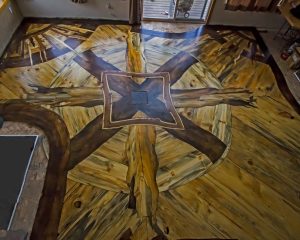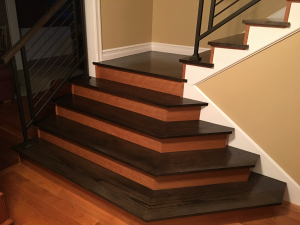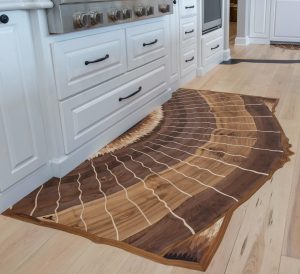Creating a custom hardwood floor is an art that goes beyond simply laying planks of wood. It’s about transforming raw materials into a cohesive, beautiful design that complements your space. At Ourada Designs, each floor we install reflects a blend of creativity, craftsmanship, and meticulous attention to detail. In this blog, I’ll take you through the two main approaches we use for installing custom hardwood floors and what makes each method uniquely rewarding.

On-Site Fabrication: Letting the Space and Materials Inspire the Design
One of the most dynamic ways to install a custom hardwood floor is by fabricating the design on-site. This approach allows the installation to evolve organically, using the wood available on location as the primary source of inspiration. It’s a fluid and creative process that relies heavily on adapting to the space, letting the materials guide the design rather than adhering to a pre-set plan.
On-site fabrication is ideal for those who appreciate a hands-on approach where the design can shift and change based on the characteristics of the room. For instance, the way light interacts with the wood or the existing architectural elements can significantly influence the final look of the floor. This method allows for a level of spontaneity and customization that’s hard to replicate in a controlled environment. It’s about making the most of what’s in front of you, ensuring that each piece of wood contributes to the overall aesthetic.
While this approach offers incredible creative freedom, it also requires a deep understanding of both the materials and the space. It’s a collaborative process between the craftsman and the environment, where every decision is made with the final vision in mind. This method is particularly suited for spaces that call for a unique, site-specific design that feels inherently tied to the location.
Precision and Control: Building in the Shop
In most cases, the process of creating a custom hardwood floor begins long before arriving on site. Much of the detailed work happens in my shop, where I can control every aspect of the build. This method involves crafting intricate designs in a controlled environment, allowing for a level of precision that’s hard to achieve on-site. From the initial cuts to the final finishes, every step is meticulously planned and executed.
Building in the shop is ideal for more complex designs that require a high degree of detail and precision. By working in a controlled setting, I can focus on perfecting each element of the floor before it’s brought to your home. This approach is particularly beneficial for designs that incorporate intricate patterns, inlays, or unique materials that need careful handling. The shop setting allows me to experiment and refine the design, ensuring that every piece fits perfectly when it’s time for installation.
When the pieces are ready, they are transported to the site and assembled like a puzzle. Each section is carefully placed, with every piece fitting seamlessly into the overall design. This method not only streamlines the installation process but also ensures that the finished floor meets the highest standards of quality and craftsmanship. However, even with meticulous planning, the unexpected can still arise, requiring quick thinking and adaptability to ensure the installation goes smoothly.

The Rhythms of Installation: On-Site vs. Shop-Built
Whether building on-site or in the shop, each installation has its own rhythm and set of challenges. On-site builds are often more spontaneous, driven by the moment and the materials at hand. They require a flexible approach, adapting the design as needed to suit the space. This method is about being present, responding to the environment, and letting the floor evolve naturally.
On the other hand, shop-built installations are more methodical, reflecting the hours of careful crafting and planning that went into each piece. There’s a unique satisfaction in seeing a design that was meticulously crafted in the shop come to life in the space. Both approaches require problem-solving skills, whether it’s finding a way to incorporate a tricky shape or making adjustments on the fly to accommodate unexpected site conditions. Ultimately, it’s not just about laying wood—it’s about creating a cohesive and beautiful result that works within the context of the room.
Crafting a Floor That Feels Like It Belongs
At the heart of every custom hardwood floor installation is the goal of creating something that feels like it belongs. Whether the design was inspired on-site or meticulously crafted in the shop, the floor should complement and enhance the space, becoming a natural extension of the room’s character. It’s the culmination of design, craftsmanship, and flexibility, all working together to transform a simple concept into a tangible work of art.

Each project is unique, with its own set of challenges and rewards. From the initial design to the final installation, every step is a journey that combines creativity and skill. The result is a floor that not only meets but exceeds expectations, adding a touch of elegance and individuality to your home. As we move forward, I’ll continue to explore the intricate details and nuances that make each custom hardwood floor installation a truly one-of-a-kind experience. Stay tuned for our next series, where we’ll dive deeper into the final touches that bring these floors to life and make them a lasting part of your home.
To learn more about my process for creating custom hardwood floors, click here.
You can also see some of the awards my floors have won here.





